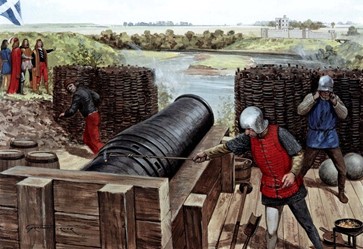This summer at the King Richard III Visitor Centre we’re making lots of medieval war machines, such as catapults and trebuchets. With that in mind, we thought it would be interesting to look at some of the siege weapons that were used in the medieval period, that weren’t built using lolly sticks, elastic bands, and plastic spoons!
The Catapult
Catapults had been a feature of siege warfare since the Romans where they were known as onagers. The device uses an arm to launch stones and other projectiles using torsion (rotation force) from ropes. Contrary to what we see in films, these weapons were rarely, if ever, used in pitched battles but rather saved for use when attacking castles and forts.

The Trebuchet
Not to be confused with the catapult, trebuchet (also known as mangonels) don’t use torsion to launch projectiles but a counterweight instead. The arm is pulled back and locked into place whilst a sling-like structure holds the projectile. Once the lock is removed, a heavy counterweight pulls the arm down, flinging the projectile an enormous distance. Trebuchet could launch much bigger projectiles than catapults with a greater force but were much larger and harder to produce. We are building some very small trebuchets at Medieval Machines but if you want to see a full-size one in action head to Warwick Castle
Siege Towers
Siege towers were large, movable towers sometimes on wheels and sometimes on rollers. Their use was to provide protection for besieging infantry moving towards fortified walls from enemy archers or defensive weapons. Some were designed with deployable bridges to allow soldiers to climb onto the enemy walls whilst others were immensely tall allowing friendly archers to fire down at the defenders.

The Hwacha
Going a bit further afield we have the hwacha. This Korean weapon was developed as early as the 12th century (possibly even earlier according to some accounts) and was later adopted by the armies of feudal China. The hwacha consisted of a wagon cart with a wooden box on top. Sounds unimpressive until you realise that the box contains either 200 rocket propelled arrows or 100 metal missiles! These projectiles would be fired together, to produce a terrifying weapon that maimed, killed and absolutely petrified enemies! The hwacha pictured here is from The War Memorial of Korea

Cannon
This may be a surprise to some but by the time of the Wars of the Roses, cannon had been a common feature of medieval warfare for decades. By the late 15th century, cannon had already developed from the primitive pot cannon of early times (basically a vase with gunpowder inside) to true cannon made from cast iron. Whilst small serpentine cannons were used in pitched battles, the large bombard cannons were only used in siege warfare to smash enemy fortifications to pieces.


